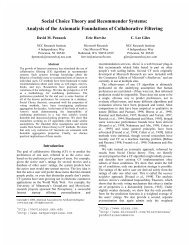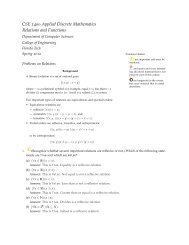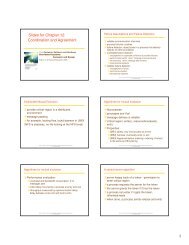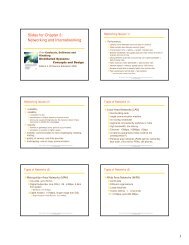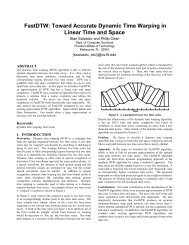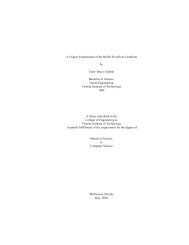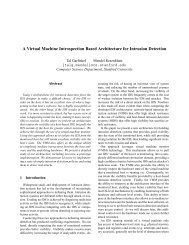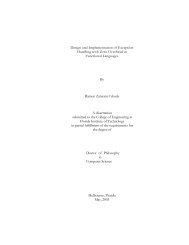Integration of Topological Constraints in Medical ... - Florent Ségonne
Integration of Topological Constraints in Medical ... - Florent Ségonne
Integration of Topological Constraints in Medical ... - Florent Ségonne
You also want an ePaper? Increase the reach of your titles
YUMPU automatically turns print PDFs into web optimized ePapers that Google loves.
4 F. Ségonne and B. Fischl<br />
2.1 General Notions <strong>of</strong> Topology<br />
Topology is a branch <strong>of</strong> mathematics that studies the properties <strong>of</strong> geometric<br />
figures by abstract<strong>in</strong>g their <strong>in</strong>herent connectivity while ignor<strong>in</strong>g their<br />
detailed form. The exact geometry <strong>of</strong> the objects, their location and the<br />
details <strong>of</strong> their shape are irrelevant to the study <strong>of</strong> their topological properties.<br />
Schematically, this amounts to characteriz<strong>in</strong>g a geometric object (i.e.<br />
a surface or a volume) by its number <strong>of</strong> disconnected components, holes<br />
and cavities, but not by their position. For <strong>in</strong>stance, the surface <strong>of</strong> a c<strong>of</strong>fee<br />
mug with a handle has the same topology as the surface <strong>of</strong> a doughnut<br />
(this type <strong>of</strong> surface is called a one-handled torus).<br />
FIGURE 2. a-b) Two tori that are homeomorphically equivalent. They share the<br />
same <strong>in</strong>tr<strong>in</strong>sic topology. However, they do not share the same homotopy type as<br />
one cannot be cont<strong>in</strong>uously transformed <strong>in</strong>to the other. c) A geometric object with<br />
a spherical topology; its Euler-characteristic is χ = v − e + f = 8 − 12 + 6 = 2.<br />
d) A geometric object with a toroidal topology and an Euler-characteristic <strong>of</strong><br />
χ = v − e + f = 16 − 32 + 16 = 0.<br />
A - Homeomorphism, Genus, and Euler-Characteristic<br />
In medical imag<strong>in</strong>g, the geometric entities under consideration are anatomical<br />
structures, which can frequently be advantageously represented by their<br />
surfaces. The Gauss-Bonnet theorem <strong>in</strong> differential geometry l<strong>in</strong>ks the geometry<br />
<strong>of</strong> surfaces with their topology. Any compact connected orientable<br />
surface is homeomorphic to a sphere with some number <strong>of</strong> handles. This<br />
number <strong>of</strong> handles is a topological <strong>in</strong>variant called the genus. For example,<br />
a sphere is <strong>of</strong> genus 0 and a torus is <strong>of</strong> genus 1. The genus g is directly<br />
related to another topological <strong>in</strong>variant called the Euler-characteristic χ<br />
by the formula χ = 2(1 − g) 3 . The Euler-characteristic is <strong>of</strong> great practical<br />
<strong>in</strong>terest because it can be calculated from any polyhedral decomposition<br />
(e.g. triangulation) <strong>of</strong> the surface by the simple formula χ = v−e+f, where<br />
v, e and f denote respectively the number <strong>of</strong> vertices, edges and faces <strong>of</strong><br />
the polyhedron. The Euler-characteristic <strong>of</strong> a sphere is χ = 2. This implies<br />
that any surface with χ = 2 is topologically equivalent (i.e. homeomorphic)<br />
to a sphere and therefore does not conta<strong>in</strong> any handles. Surfaces with an<br />
Euler-characteristic χ < 2 have a topology that is different from that <strong>of</strong> a<br />
3 In the case <strong>of</strong> multiple surfaces <strong>in</strong>volv<strong>in</strong>g K connected components, the total genus<br />
is related to the total Euler-characteristic by the formula: χ = 2(K − g).


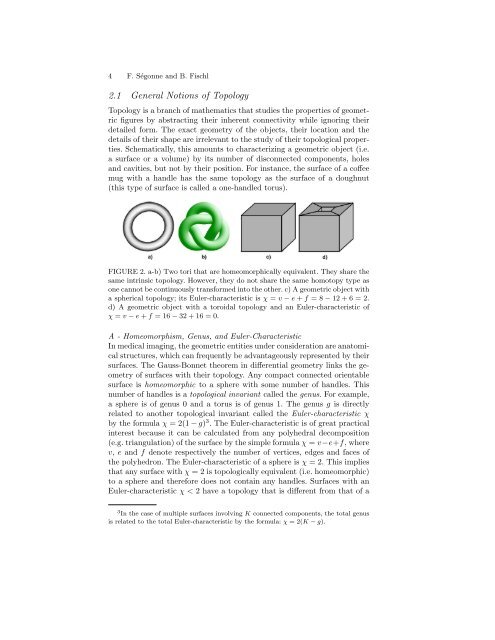
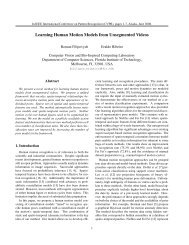
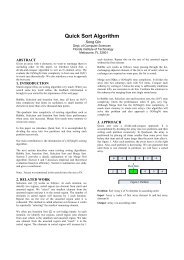
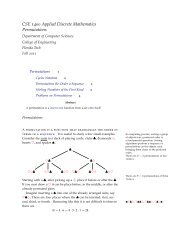
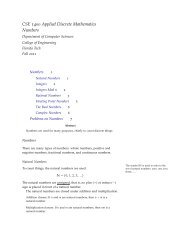
![{ public static void main (String[] args) { System.out.println (](https://img.yumpu.com/49719541/1/190x143/-public-static-void-main-string-args-systemoutprintln-hello-.jpg?quality=85)
